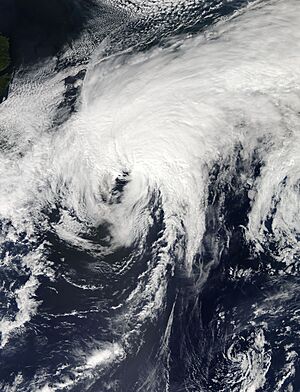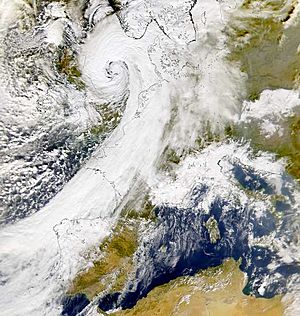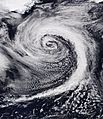Extratropical cyclone facts for kids
An extratropical cyclone is a type of cyclone. It is a large area of low pressure in the atmosphere, bringing clouds, rain, and strong winds. These storms usually happen in areas between 30° and 60° latitude from the equator. They are different from tropical cyclones, which form closer to the equator. Extratropical cyclones are often made up of different air masses, like cold and warm fronts. They can cause rain, strong winds, and sometimes even tornadoes or hail.
In the Northern Hemisphere, an extratropical cyclone spins counter-clockwise. These storms are usually round or oval-shaped and can be about 1,000 kilometers (620 miles) wide. They are often linked to "fronts," which are boundaries where different air masses meet. When a very cold air mass meets a very hot air mass, it causes changes in the weather. Inside the cyclone, there is a system of warm fronts and cold fronts. The center of the cyclone is usually very cloudy, and there's a high chance of rain or snow.
When a warm front passes, the wind gets strong and changes direction. The weather can become stable, and fog is common. As a cold front passes, the wind changes again, the temperature drops, and rain is also common.
Contents
How Extratropical Cyclones Form

Some extratropical cyclones start as tropical cyclones that move over colder water. When a tropical cyclone moves away from warm tropical waters, it might lose some of its strength. However, sometimes these storms can change into extratropical cyclones and even become stronger than they were before. If they started as a tropical cyclone, they might still have an "eye" – a calm, clear area in the middle of the storm.
Sometimes, strong extratropical cyclones called European windstorms form when winds from the northwestern Atlantic Ocean carry them towards Europe. Another type of extratropical cyclone is a Nor'easter, which often hits the northeastern part of North America. These storms usually form in late fall or winter when cold air is present. Winds from the western Atlantic move them north, making them stronger and bringing heavy snow to the areas they hit.
When a Nor'easter or any extratropical cyclone gets much stronger very quickly (meaning its pressure drops a lot in a short time), it's sometimes called a "weather bomb." For example, Hurricane Hazel became an extratropical storm but was still very powerful, like a hurricane, when it hit Toronto.
Life Cycle of a Cyclone
Extratropical cyclones often appear in groups, sometimes called "families of cyclones." Usually, there are three or four cyclones at different stages of their life cycle.
A cyclone goes through several stages:
- Stage 1: Beginning The cyclone starts to form.
- Stage 2: Strengthening The cyclone gets stronger. At this point, both the warm and cold fronts are very large, and the system moves quickly. The cold front usually moves faster than the warm front. This can cause the cold front to catch up to the warm front, forming an occluded front. The weather during an occluded front can be a mix of what you'd expect from both warm and cold fronts.
- Stage 3: Weakening The storm starts to fill with air, and the pressure inside rises.
- Stage 4: Disappearing The signs of the cyclone's weather slowly fade away.
Notable Storms
Throughout history, many powerful extratropical cyclones have caused significant impacts.
- A very strong storm during the Crimean War on November 14, 1854, sank 30 ships. This event led to the first studies of weather forecasting in Europe.
- In the United States, the Columbus Day Storm of 1962 was one of many strong windstorms to hit the Pacific Northwest.
- Hurricane Sandy also changed into an extratropical storm before it made landfall.
| Cyclones and Tropical cyclones of the World |
|---|
| Cyclone - Tropical - Extratropical - Subtropical - Mesocyclone - Polar cyclone - Polar low |
Images for kids
-
A powerful extratropical cyclone over the North Atlantic Ocean in March 2022
-
QuikSCAT image of typical extratropical cyclones over the ocean. Note the maximum winds are on the outside of the occlusion.
See also
 In Spanish: Ciclón extratropical para niños
In Spanish: Ciclón extratropical para niños












